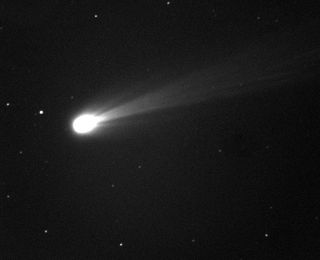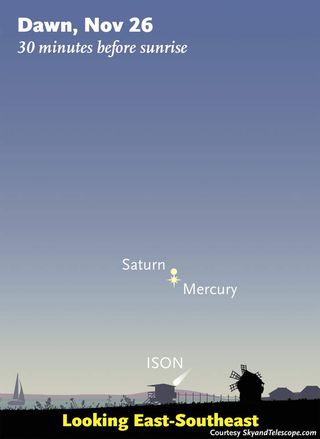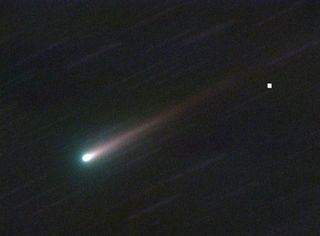How Bright Will Comet ISON Get? Only Time Will Tell

The potentially dazzling Comet ISON is currently visible to the unaided eye — a milestone for the comet's much-anticipated pass through the inner solar system — but its future all depends in how it reacts to a close Thanksgiving encounter with the sun, comet observers say.
Comet ISON can be seen low in the southeastern sky an hour before dawn, weather permitting, but it is en route for an extremelyclose flyby of the sun on Thanksgiving Day (Nov. 28). Will it break apart due to the sun's gravity and heat, or will the comet emerge victorious from its solar rendezvous and shine bright in the night sky? No one knows for sure yet, said Alan MacRobert, senior editor for Sky & Telescope magazine, in a skywatching guide this week.

"We might witness a nice, long-tailed comet visible to the naked eye that will leave millions of people with fond memories for a lifetime," MacRobert said. "Or maybe it will be a small comet for sky hunters using binoculars and a good map of its position. Or it might yet break up and vanish." [How to See Comet ISON: An Observer's Guide]

Comet ISON's nucleus, or core, will have to survive its closest encounter with the sun on Nov. 28 around 2 p.m. EST. (1900 GMT) Surface temperatures are expected to peak at 2,700 degrees Fahrenheit (4,900 degrees Celsius). That's hot enough to melt iron, let alone the ices that make up the comet's core.
There are also worries among skywatchers that the rapid rotation of Comet ISON's nucleus, a mere 10 hours, could put the comet in danger of disintegrating as it contends with the strong tidal forces from its brush with the sun's intense gravity.
If the comet does break apart, however, Sky & Telescope experts said the view could still be "glorious." With more pieces exposed to the sun, the brightness of the fragments could still put on a good show.

To catch a glimpse of ISON, the magazine recommends using binoculars as the comet is harder to spot with your bare eyes unless you know exactly where to look. Comet seekers should find a dark spot with an unobstructed view of the east-southeast horizon. Go out at least an hour before dawn and look for a fuzzy blob nearby the bright planets Saturn and Mercury, and naked eye star Spica.
Get the Space.com Newsletter
Breaking space news, the latest updates on rocket launches, skywatching events and more!
Comet ISON was discovered in September 2012 by Russian amateur astronomers Vitali Nevski and Artyom Novichonok using the International Scientific Optical Network (ISON) of remotely operated telescopes. The comet's official designation is C/2012 S1 (ISON).
Editor's note: If you snap an amazing picture of Comet ISON or any other night sky view that you'd like to share for a possible story or image gallery, send photos, comments and your name and location to managing editor Tariq Malik at spacephotos@space.com.
You can follow the latest Comet ISON news, photos and video on SPACE.com.
Follow Elizabeth Howell @howellspace and SPACE.com @Spacedotcom. We're also on Facebook and Google+. Original article on SPACE.com.
Join our Space Forums to keep talking space on the latest missions, night sky and more! And if you have a news tip, correction or comment, let us know at: community@space.com.

Elizabeth Howell (she/her), Ph.D., is a staff writer in the spaceflight channel since 2022 covering diversity, education and gaming as well. She was contributing writer for Space.com for 10 years before joining full-time. Elizabeth's reporting includes multiple exclusives with the White House and Office of the Vice-President of the United States, an exclusive conversation with aspiring space tourist (and NSYNC bassist) Lance Bass, speaking several times with the International Space Station, witnessing five human spaceflight launches on two continents, flying parabolic, working inside a spacesuit, and participating in a simulated Mars mission. Her latest book, "Why Am I Taller?", is co-written with astronaut Dave Williams. Elizabeth holds a Ph.D. and M.Sc. in Space Studies from the University of North Dakota, a Bachelor of Journalism from Canada's Carleton University and a Bachelor of History from Canada's Athabasca University. Elizabeth is also a post-secondary instructor in communications and science at several institutions since 2015; her experience includes developing and teaching an astronomy course at Canada's Algonquin College (with Indigenous content as well) to more than 1,000 students since 2020. Elizabeth first got interested in space after watching the movie Apollo 13 in 1996, and still wants to be an astronaut someday. Mastodon: https://qoto.org/@howellspace
